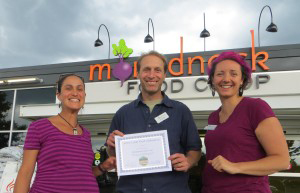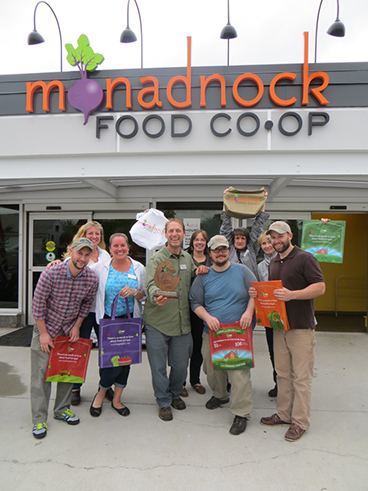Courageous leadership relies in large measure on wise choices. In his entertaining novels, Robert Parker often references the military strategist Clausewitz for the proposition that you should “plan not for what you think your enemy will do, but rather for what your enemy can do.”
Wise leadership, in other words, requires that we prepare not only for the probable but also for the possible. In the language of strategic leadership, we must exercise foresight.
What else is required for strategic leadership? Resilience, curiosity, openness, a commitment to learning: the list is a long and demanding one.
Defining purpose, setting direction
Strategic leadership is one of the Four Pillars of Cooperative Governance. As Marilyn Scholl and Art Sherwood describe in their article on the Four Pillars (CG #170, Jan.¬Feb. 2014), “Strategic leadership is about defining purpose and setting direction.”
For a cooperative board of directors, purpose is often articulated in written policies that are entrusted to the co-op’s general manager for implementation. To facilitate movement toward accomplishing those purposes, the board chooses, empowers, and supports the co-op’s general manager; ensures that there are adequate resources for the cooperative; and monitors progress towards accomplishing those purposes.
As noted by Sherwood and Scholl, “Providing strategic leadership requires information, knowledge, and wisdom. Boards need to be able to learn and build wisdom together in order to develop foresight and make informed decisions.”
It has been several years now since Sherwood began writing his powerful articles for this magazine—articles that highlight and make accessible the fundamentals of strategic leadership. In that time, we have seen more and more co-op boards of directors creating cultures of learning and curiosity, supporting and learning with their general managers about their business, their communities, and their owners. We see cooperatives, in order to accomplish their goals, practicing strategic leadership by paying close attention to such things as board development, capital needs, and internal and external trends and changes.
Monadnock Food Co-op case study
Monadnock Food Co-op, in Keene, N.H., is one of the latest wave of food co-ops, and it is a great example of the positive impact that comes of strategic leadership. It also offers an opportunity to look closely at each of the components of a cooperative board’s strategic work.
Monadnock incorporated in April of 2010, hired General Manager Michael Faber in 2011, and opened in April of 2013. To ensure adequate resources for the co-op to achieve its goals, the Monadnock board conducted a very successful member loan campaign. Partnering with the local economic development authority, the co-op has constructed a beautiful store in the heart of the downtown area.
The Monadnock board is consistently and regularly monitoring the co-op’s progress towards achieving its goals. At the same time, the board is also devoting substantial time and thought to preparing for decisions that it can foresee will need to be made about the co-op’s future.
Articulating purpose
Well before the store opened its doors, the Monadnock board engaged with its community to understand community needs. Based on that engagement, the board adopted policies that “articulate the key results we aim toward.”
The Monadnock Food Co-op is cooperatively owned and operated by people in our community and exists to meet our community’s need for:
- An accessible, community-owned downtown food market;
- A marketplace that welcomes and connects community;
- A healthy, sustainable food system;
- The support of local farmers and producers;
- Appropriate education and training for the community;
- A strong, sustainable and improving local economy.
- (https://monadnockfood.coop/about/)
Ensuring adequate capital means learning together
Although the store is only three years old, Monadnock’s board will make its first decision concerning patronage allocation this year. Patronage allocation, which takes into account both the cooperative’s current and future capital needs, is an excellent example of a strategic board decision that requires and inspires learning throughout the cooperative. Everyone in the co-op can benefit from learning about the resource implications of the patronage allocation decision. How much money did the co-op earn doing business with its owners? How should that money be used? What proportion should be retained for working capital, what proportion paid out to owners?
A learning culture is a resilient culture because it is one that is less likely to be unpleasantly surprised. When the board of directors shares with the cooperative’s members not only its decisions but also its learning process and strategic considerations, that strengthens the cooperative. It is harder to surprise or disappoint owners who understand the co-op’s market and community through the same lens and context that its board is using. And since changes are to be expected and in fact are invited, this shared learning is critical to successful cooperation.
At Monadnock, the store has been so successful in such a short time that board member Kathy Burke says the board is working strategically at every level, trying to look into the future to be ready to make whatever decisions may be needed. The Monadnock board recognizes that in two more years, the co-op will reach some key milestones related to its financing. The board is educating itself about the co-op’s future capital needs to ensure that the upcoming patronage decision will take all of the co-op’s future needs into account.
Focus on leadership development
I never fail to be amazed at the depth of communication that cooperation requires. Cooperators never learn alone because, in order to keep pace with an ever-changing world and market, the cooperative needs to share information and learning throughout the organization. As the world of retail food becomes ever more complex, our cooperative boards of directors are finding more ways to share this complexity with the co-op’s owners. And in doing so, boards foster the development of strong leaders from within the cooperative, people who can rise to the demands of this challenging world.
At Monadnock, Burke emphasizes the importance of board development to their strategic leadership process. “To start with, we are building a good board that understands process, policy governance, the board’s role and the general manager’s role, and developing a comprehensive orientation process to support and maintain the board.”
The co-op’s emphasis on strategic board development is no accident. Burke related that at a recent board retreat, consultant Marilyn Scholl asked the members, “How did you get on the board?” In discussion, the board members realized that they had been encouraged by two prior board members who had done a skillful job of identifying board candidates who were thoughtful, team players, and who had a wide array of ties to the community. In relating the story, Burke paused for a moment to celebrate the foresight of those leaders, and in the silence I could hear her board’s dedication to keeping that spirit alive in the co-op.
Role clarity and resilience
Role clarity is another important attribute of successful strategic leadership. In order to succeed, cooperatives foster good boundaries that ensure that decisions are made by the people who are best qualified to make them. Co-op members adopt bylaws, elect board members, and participate in their cooperatives by shopping the store, showing up for meetings and engagement opportunities, and telling the co-op’s story, among other things. The co-op’s board hires and empowers a general manager (GM) and holds the GM accountable. The co-op GM in turn hires and empowers an excellent staff of dedicated professionals.
At the Monadnock board’s annual retreats, they have been continuing to learn together to build alignment around growth—understanding what growth looks like and how the co-op could get there. As a result, Burke says, “We’re constantly looking at the trends. Is our current store in line with the trends?” The store is planning a reset and recently expanded its offerings for prepared foods, to be sure that its retail systems are strong. In Burke’s words, the board and GM want to be sure that “if an opportunity presents itself, the GM can focus on it.”
Where will opportunities come from? Monadnock’s board doesn’t know right now. And it’s doing its best not to be distracted by that uncertainty. “We want to be sure we understand the trends, so we will know a good opportunity when it presents itself.” The board is relying on its GM to manage the specifics. “We have a great general manager. We trust our general manager. We have thoughtful, engaged board members, and we can do this work and feel like we are supporting each other.”
Even with all of their awareness, however, Burke acknowledged that at one board meeting in the last year the Monadnock board got off track in discussing one potential opportunity that the GM had just started to explore. “The GM presented it, and the board began to analyze it right away, instead of saying, ‘Thank you. Let us know what happens as you research it.’ Wow, it was good to have that experience and to reflect on it. Next time, we’ll do it better.”
That resilience and attentiveness to role clarity will serve Monadnock well. Co-op consultant Bill Gessner advises strategically minded cooperatives, whether they are starting up or are embarking on an expansion or growth strategy, to invest 80 percent of their effort on their “Plan A,” 15 percent on “Plan B,” and 5 percent on “Plan C.” Then, if (when) Plan A falls through, they can move Plan B up to become the new Plan A, and Plan C can become the new plan B. For a co-op general manager, who may review a whole alphabet’s worth of possibilities before finding the option that can be turned into results, having a board that is both curious and resilient in the face of change is essential to excellence.
Implement, monitor, reflect, repeat
The process of strategic leadership is a circular process, in which cooperatives learn from their lived experience. In the recorded workshop discussing the “Ends to Ends Strategic Process,” https://library.columinate.coop/ends-to-ends-strategic-process/, Art Sherwood and Michael Healy offer a process model that begins with articulating the co-op’s purposes; continues through interpretation, planning, and action; and then cycles through a phase of monitoring and reporting on how well the activities met the co-op’s goals. The cycle begins again with a renewed reflection on those purposes and goals, with the benefit of the wisdom gained from experience.
Looking ahead, the Monadnock board intends to clarify its Ends, and it will keep looking at trends to understand the community, the members and their needs, and to understand the co-op’s capital needs. There is a lot of work still to come in engaging with members and building alignment around the co-op’s future. But given the work that has been done to date, there’s every reason to expect that the Keene, N.H., community will benefit from the excellent strategic thinking of the Monadnock Food Co-op’s board of directors.
Bridging uncertainty, creating results
In the face of the chasm of uncertainty that we bridge between now and the next moment, I sometimes think it’s a wonder anyone gets anything done at all. And when I consider the complexity of the interpersonal dynamics that operate in a group setting, it seems even more remarkable. And yet, again and again, cooperative boards, managers, and owners use strategic thinking and excellent communication to connect the dots and to cross that seemingly impossible barrier between imagination and action, transforming their communities. Congratulations and thanks to Monadnock. Here’s to your courageous, strategic leadership!
Resources
“Strategic Leadership Is a Cooperative Effort,” by Art Sherwood, in Cooperative Grocer, May¬June 2014.
“Cooperative Strategic Leadership,” by Art Sherwood, in Cooperative Grocer, July¬August 2011
“Servant Leadership and Cooperation,” by Joel Kopischke, in Cooperative Grocer, July¬August 2013. Servant Leadership and Cooperation
“Ends to Ends Strategic Process,” CBLD Online Recorded Workshop, by Art Sherwood and Michael Healy
Have more questions?
Get in touch with one of our consultants.



